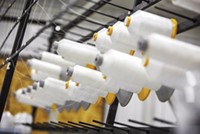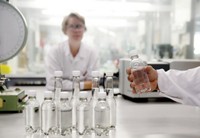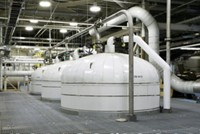Advertisement
Grab your lab coat. Let's get started
Welcome!
Welcome!
Create an account below to get 6 C&EN articles per month, receive newsletters and more - all free.
It seems this is your first time logging in online. Please enter the following information to continue.
As an ACS member you automatically get access to this site. All we need is few more details to create your reading experience.
Not you? Sign in with a different account.
Not you? Sign in with a different account.
ERROR 1
ERROR 1
ERROR 2
ERROR 2
ERROR 2
ERROR 2
ERROR 2
Password and Confirm password must match.
If you have an ACS member number, please enter it here so we can link this account to your membership. (optional)
ERROR 2
ACS values your privacy. By submitting your information, you are gaining access to C&EN and subscribing to our weekly newsletter. We use the information you provide to make your reading experience better, and we will never sell your data to third party members.
Materials
Milking A Market
Two biobased chemical firms tackle the lactide business with different approaches
by Michael McCoy
November 25, 2013
| A version of this story appeared in
Volume 91, Issue 47

Behind every great polymer is a great monomer. That’s the theory that has prompted two biobased chemical companies, NatureWorks and Corbion Purac, to invest in new facilities that produce lactide.
Both firms are betting that lactide, the cyclic diester of lactic acid, has the potential to be a versatile building block for all sorts of biobased materials that can replace synthetic products. Both have come out with manufacturing improvements that they say will overcome past monomer shortcomings. But they have different technologies and approaches to the market, and it remains to be seen who the winner will be.
Active in many of nature’s biochemical processes, lactic acid has been made industrially via fermentation for more than a century. Corn, sugarcane, and other crops can be used as sources of sugar to ferment.
Purac’s corporate predecessor started manufacturing lactic acid in the Netherlands in 1931 as an ingredient for wool and leather dyes.
In the 1980s, Purac entered the lactide polymers business with specialized biodegradable plastics for medical use. In 2002, NatureWorks, then a joint venture of Cargill and Dow Chemical, opened a plant in Blair, Neb., that turns corn-derived lactic acid into large quantities of lactide for polylactide manufacturing.
NatureWorks succeeded in making lactide-based polymers the world’s largest-volume bioplastics after starches. The plant in Blair can produce 150,000 metric tons per year each of lactide and polylactide, and NatureWorks recently chose Thailand as the likely site for its second facility. Last year Purac opened a 75,000-metric-ton facility in Thailand to produce plant-derived lactide for polymer applications.
Although polylactide is successful, it has until recently been held back by melting point and crystallinity problems related to the monomer’s natural origins.
Lactic acid, like many chemicals involved in biological processes, is chiral, with two stereoisomers. Converting the acid into lactide yields three stereoisomers: (R,R)- or
On their own,
In particular, the 4% or so of
What NatureWorks and Purac have done is turn the problem of lactic acid’s stereochemistry into an opportunity by creating separate streams of the stereoisomers and using them like petrochemical comonomers to fine-tune polymer properties. But their technologies and approaches to the market are quite different.
Earlier this year at the Blair plant, NatureWorks completed the installation of purification equipment provided by the Swiss engineering firm Sulzer. NatureWorks isn’t detailing how, but it says the technology permits the launch of polymer grades that have better heat resistance and allow customers to reduce by up to 75% the time, known as cycle time, it takes to extrude or mold an object from the polymer.
The purification equipment also yields what NatureWorks calls the world’s first commercial quantities of meso-lactide. Manuel Natal, the firm’s segment leader for lactide derivatives, says meso-lactide offers properties not found in
Notably, it has a melting point below 60 °C. This compares with a melting point of around 97 °C for
Purac, in contrast, doesn’t sell meso-lactide and, with the exception of the medical-grade material, doesn’t sell polymers either. Instead, according to François de Bie, the firm’s marketing director for bioplastics, Purac concentrates on making the best lactide it can and selling it to the polymer industry.
For de Bie, this is the 99.9% pure
A key selling point for Purac is that customers can use the two monomers to make polylactide that withstands temperatures of up to 180 °C and is amenable to the fast cycle times of high-volume manufacturing. De Bie sees meso-lactide as the low-value by-product of a less than optimal fermentation process. “We make as little as possible of meso,” he says.
Both companies point to successes with their respective approaches to lactide. Natal notes that the chemical maker Stepan is using lactide from NatureWorks to produce lauryl lactyl lactate, a surfactant derived entirely from plant-based raw materials. Stepan markets it to personal care companies as an ingredient for bodywashes, facial cleansers, hair conditioners, and the like.
Toyobo, a Japanese chemical company, is reacting lactide from NatureWorks with caprolactone to produce copolymers for applications such as adhesives, coatings, and inks.
Although NatureWorks’ main business is polylactide, Natal foresees a companion lactide business that sells tens of thousands of tons per year. He draws an analogy between lactide and ethylene, the petrochemical industry’s key building block. Most ethylene is converted into polyethylene, but a significant portion goes into ethylene glycol, α-olefins, and other specialized chemicals.
Purac also boasts numerous lactide customers, several of which it revealed at the recent K plastics show in Germany. The company announced it is working with the films company Innovia to develop a polylactide film for packaging and industrial applications. And it has teamed up with the Taiwanese firms Supla and Kuender to create the world’s first bioplastic touch screen computer.
Other Purac partnerships, according to de Bie, include one with China’s Yangtze Labre to make polylactide fibers for textile applications and one with the Dutch firm Synbra around polylactide foam that can replace polystyrene foam in surfboard cores. Earlier this year Purac joined with the Swedish chemical maker Perstorp to develop caprolactone-lactide polymers for coatings, adhesives, sealants, and elastomers.
Although Purac’s de Bie and NatureWorks’ Natal back different technologies and have different marketing philosophies, they acknowledge one point of agreement: Their main competition isn’t each other but the oil- and gas-derived products made by the rest of the chemical industry.
Henton, the consultant, says the competition is healthy
“You just have to look at the scale of our factories compared with the global polystyrene market,” he says. “You can easily see that the competition is not between the polylactide and lactide producers but between bioplastics and traditional plastics.”






Join the conversation
Contact the reporter
Submit a Letter to the Editor for publication
Engage with us on Twitter